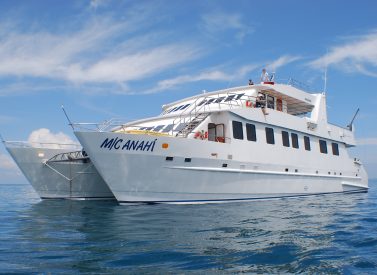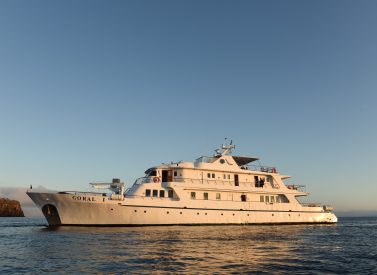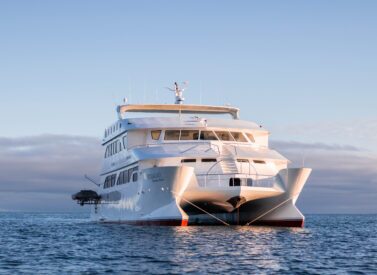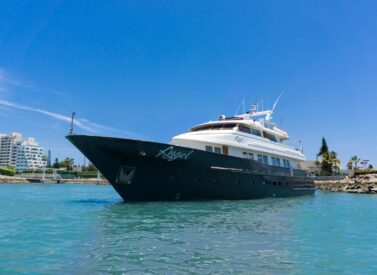
Beluga First Class Yacht, Galapagos Cruise
A Beluga cruise a luxury holiday to a unique wildlife destination.
The Beluga is a superior first class motor yacht, perfect for discovering the Galapagos in style.
Top guides lead you to see incredible wildlife as well as explain the dramatic volcanic – and human – history of Galapagos.
While aboard the Beluga, enjoy excellent food and service while gazing out at the islands from the large sundeck and communal areas.
Enjoy panoramic views and the large sundeck, looking for wildlife in between expert guided land and sea tours.
More about Beluga, Galapagos
The Beluga has twin, double and a triple air-conditioned rooms, each with private bathroom and hot & cold water showers.
The Beluga’s friendly and professional crew takes care of all the details so you get the most from your Galapagos holiday.
Trip Highlights
Print Share Download as PDF-
Spacious, comfortable way to see the Galapagos, with attention to detail.
-
Awarded the “Smart Voyager Certification” for adhering to conservations standards.
-
Twin, double cabins and one triple cabin, all with private bathroom, hot/cold shower and air conditioning.
-
Makes the complete loop of the Western Islands one week, heads north to Genovesa the next - very complete.
-
Three meals served daily, after-excursion snacks and non-alcoholic beverages.
-
Panoramic windows in the salon / dining area, and a large sundeck for relaxing, sightseeing or sunbathing.
The Beluga, her crew and the other passengers were all brilliant. Our guide Darwin was outstanding... the kids all adored him and were like bees round a honey pot whether snorkelling or hiking up the volcanoes. His knowledge of the islands, geology, plants, animals, marine life and culture was endless and he was great fun.
We saw so much of the remarkable wildlife of the Galapagos and were also very lucky to see a pod of pilot whales while we were navigating just after crossing the equator which was so exciting and also some bottle nose dolphins. The highlight was probably snorkelling with the sea turtles.
J. Walker, Beluga
Full Itinerary
Tower itinerary
Tower itinerary (8 days) Wed-Wed
Hood itinerary (6 days) Fri-Wed (days 3-8 below)
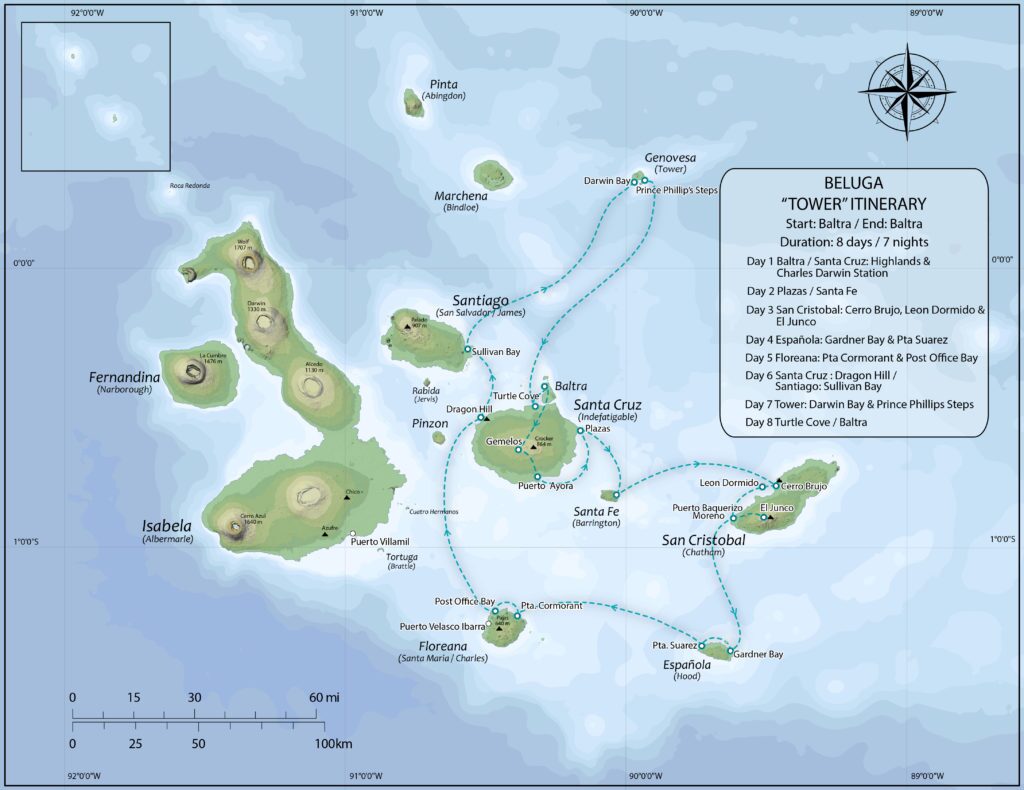
Day 1: Arrive Baltra, transfer to boat – HIghlands & Charles Darwin Station (L,D)
After landing in Galapagos, you first pay the national park entry fee and then leave the arrivals hall to where your guide will be waiting for you.
After getting the group together, the guide then takes you to the boat to settle in. The island of Baltra is the only island in the entire Galapagos archipelago that is not completely included in the National Park Area.
After lunch we head to the Highlands. The scenery gradually changes as we wind our way through all seven vegetation zones found in Galapagos. Here more than anywhere, on the most populated islands on the Galapagos, the problems of introduced animals and plants are quite obvious. This part of the island is not National Park. When we reach the highest point of the road, we are back in the National Park and we head to ‘El Chato’, a farm in the highlands where we can look out for the Galapagos Tortoises in their natural, and free, surroundings.
Next is our visit to the Charles Darwin Research Station. This gives you the opportunity to get to known the scientific work that’s currently taking place in the National Park, particularly projects raising the different subspecies of Galapagos tortoises. Scientists from all over the globe work at the station and conduct biological research from anatomy to zoology. It is also a good opportunity to observe the Galapagos tortoises close up.
Head to the yacht for dinner and briefing.
Day 2: South Plaza - Santa Fe (B,L,D)
South Plazas is a small island, a geological uplift, and has spectacularly tall cliffs (up to 25m) that offer fantastic views on the southern side, and sea lions to the north.
During the rainy season (Jan-May) the island is an intense green, where as in the drier months the ground vegetation changes to a bright orange then purple. Throughout the island we find several hybrid iguanas, a result of crossing a male marine iguana and a female land iguana. These unique animals, recognisable at first glance by their black/grey colour, have the face and tail of the marine iguana.
It’s a dry landing on a jetty, the trail leads us through Prickly Pear or Opuntia and Sesuvium. Here we can find the Galapagos land iguana feeding on the cactus leaves.
Toward the end of the hill, we encounter a colony of bachelor sea lions. We also find Swallow-tailed Gulls, Shearwaters and Red-billed Tropicbirds who build their nests along the cliffs.
Return to the yacht for lunch.
Santa Fe is a small island of 24 km2. The visitor site Santa Fe is located on the northeast end of the island. Highlights include Santa Fe land iguanas, pelican nesting site, sea lion colony, mockingbird, and Palo Santo trees.
Return to the yacht for a briefing and dinner.
Day 3: San Cristobal Island - Witch Hill - La Galapaguera (B,L,D)
Cerro Brujo (Witch Hill) is a breathtaking white coral beach, considered one of the most spectacular in Galapagos and perfect for a peaceful walk with expansive views and good bird watching. There is the opportunity to snorkel or kayak from the beach or swim with sea lions as well as the Zodiac ride.
Return to the Beluga for lunch.
In the afternoon we visit Galapaguera and El Junco, a freshwater crater lagoon. We can admire the views over San Cristobal highlands and at Galapaguera see giant tortoises in the wild.
Return to the yacht for a briefing and dinner.
Day 4: Española (Hood): Gardner Bay – Islote Gardner and Osborn – Punta Suarez (B,L,D)
Wet landing on a wonderful, long, white beach made of coral sand at Gardner Bay (Española). For this visit you won’t even need shoes, it’s so soft underfoot, and there is no trail to follow so you can take a long walk and explore a bit. Playa Gardner is a very good place to observe finches and mockingbirds in the saltbush vegetation, and there is some great swimming and snorkelling from the beach, where curious sea lions are never far off. Some will even launch with you from the beach and into the water.
Islote Gardner and Islote Osborn are snorkelling sites where visitors will see an abundance of tropical fish, reef sharks, and turtles.
Return to the yacht for lunch.
Sea lions will usually give a noisy greeting to us as we make a dry landing on a jetty at Punta Suarez and head to the beach. Curious Hood Mockingbirds may peck at our shoelaces.
From April to December, the Waved Albatross, found only on Española, perform their wild mating ritual.
Colonies of Blue-footed Boobies show off for potential mates, Nazca Boobies care for their young while at night the stunning Swallow-tailed Gull – the only nocturnal gulls in the world that fish at night – take to the air.
There’s more – Darwin’s Finches, Galapagos Doves and Galapagos Hawks, plus a unique species of marine iguana with traces of red and green colourings. A real highlight is the blowhole. Here, the seawater is pushed through a fissure in the cliff under great pressure. Depending on the waves and tide levels, the blowhole can force water up to 80ft (24m) into the air.
Return to the yacht for a briefing and dinner.
Day 5: Floreana: Cormorant Point - Devil's Crown - Post Office Bay (B,L,D)
Floreana is the least populated island in Galapagos and has a rich and mysterious anthropological history.
The mood is set at the wet landing, as your toes touchdown on seemingly green sand with the backdrop of barking sea lions.
We’ll leave out the history of the island for your guide to explain, but we can tell you that you will follow a trail to a brackish lagoon, home of the Pintail Ducks, Common Stilts, and the Greater Flamingos – the pinkest in the world. The colour theme continues as we come to the “White Flour Sand Beach” made of white corals. It’s a famous nesting beach for marine turtles and for this it is important to not walk on the sand dunes. Often we see a lot of stingrays in the shallow water.
Devil’s Crown (Floreana): This is one of the most famous snorkelling sites in the Galapagos, a real highlight. Devil’s Crown is the remains of a volcano some of which has been subsumed by the sea, but with the crater horns still exposed, it looks like a black crown emerging out of the sea. Once in the water, expect to see a brilliant array of colourful fish and corals.
Important: There is often a current at Devil’s Crown.
One of Galapagos’ most famous sites is Post Office Bay. Here resides a post barrel, erected and put into use in the late 18th century by English whaling vessels. Following a wet landing we head to the barrel and you can leave a postcard of your own for some other traveller to pick up and help towards its final destination, and pick up any mail from your area for you to distribute once back home. It’s a great tradition to keep up. There is a snorkel from the beach and take a zodiac ride throughout the shallow area in front of Baroness Point.
Return to the yacht for a briefing and dinner.
Day 6: Dragon Hill - Sullivan Island (B,L,D)
Located on the northern tip of Santa Cruz is Cerro Dragon aka Dragon Hill, offering great views over the Galapagos.
As we walk towards the viewpoint, the trail passes a saltwater lagoon replete with Pink Flamingos as well as other lagoon birds; Stilts, Pintail Ducks, Sandpipers and more. We’ll most likely see Darwin Finches, Galapagos, Flycatchers, Yellow Warblers, Audubon Shearwater and the endemic land iguanas en route too. From the top of the hill, we enjoy a majestic view of the bay island covered in Opuntia cactus, Palo Santo and Cordia Lutea (muyuyu).
We take lunch, and then sail towards Sullivan Island, located between Isabela and Santa Cruz. It’s known for a great amount and variety of birds but we will also see many marine iguanas and Galapagos fur seals.
Our visit to Sullivan Bay is like stepping into a different world. The dry landing is on a jetty, then the summit trail and stairs lead us on a 30 minute climb to the top of Bartolomé, a once active volcano.
Along the way, we pause to marvel at lava bombs, spatter cones and cinder cones. From the top of the wooden stairs, we can gaze out across the island for a panoramic view of the island and Pinnacle Rock, an eroded tuff cone. Crystal clear water is an invitation to snorkel from the beach with schools of tropical fish and Galapagos Penguins or take a zodiac ride to spot them.
Return to the yacht for the evening briefing and dinner.
Day 7: Tower: Darwin Bay - El Barranco (B,L,D)
Genovesa is considered to be one of the most spectacular islands in Galapagos for bird species and is home to the red-footed booby. It’s a wet landing on Darwin Bay, a coral sand beach where Swallow-tailed Gulls and Lava Gulls gather near the tide pools.
A trail leads us through red mangrove and salt bush, then we enter a forest of Opuntia cactus where colonies of Great Frigate nest. The males of this species inflate their red-throated pouches to attract females as they fly overhead. A few Nazca Boobies nest on the ground, and the trail leads along small tide pools up to a cliff with a spectacular view over the caldera.
At low tide there are thousands of Galapagos Fiddler Crabs to see on the sandy shore.
After lunch aboard the ship, we head to El Barranco in the dinghy. There is a good chance of seeing the unique Short-eared owl at this site. During the dinghy rides along the cliffs fur seals and several species of seabirds can be spotted.
Dinner on the yacht completes your day.
Day 8: Turtle Cove, transfer to Baltra airport for flight out, tour ends (B)
Our final visit today is a real highlight – into the panga (dinghy) and then into a mangrove cove called Turtle Cove.
There are many coves and inlets to explore, and your guide will often turn off the motor so you drift along. Keep an eye out for pairs of mating sea turtles (Sept to Feb), white-tipped reef sharks and golden cow-nosed rays, as well as eagle rays, golden rays and young Galapagos sharks.
After this visit we transfer to the airport for your flight back to the mainland.
Beluga Fernandina Itinerary
Fernandina itinerary
Fernandina itinerary (8 days) Wed-Wed
Isabela itinerary (6 days) Fri-Wed (days 3-8 below). Passengers miss day three’s activities and need to overnight in Isabela or Santa Cruz the Thursday before the cruise starts (not included in price).
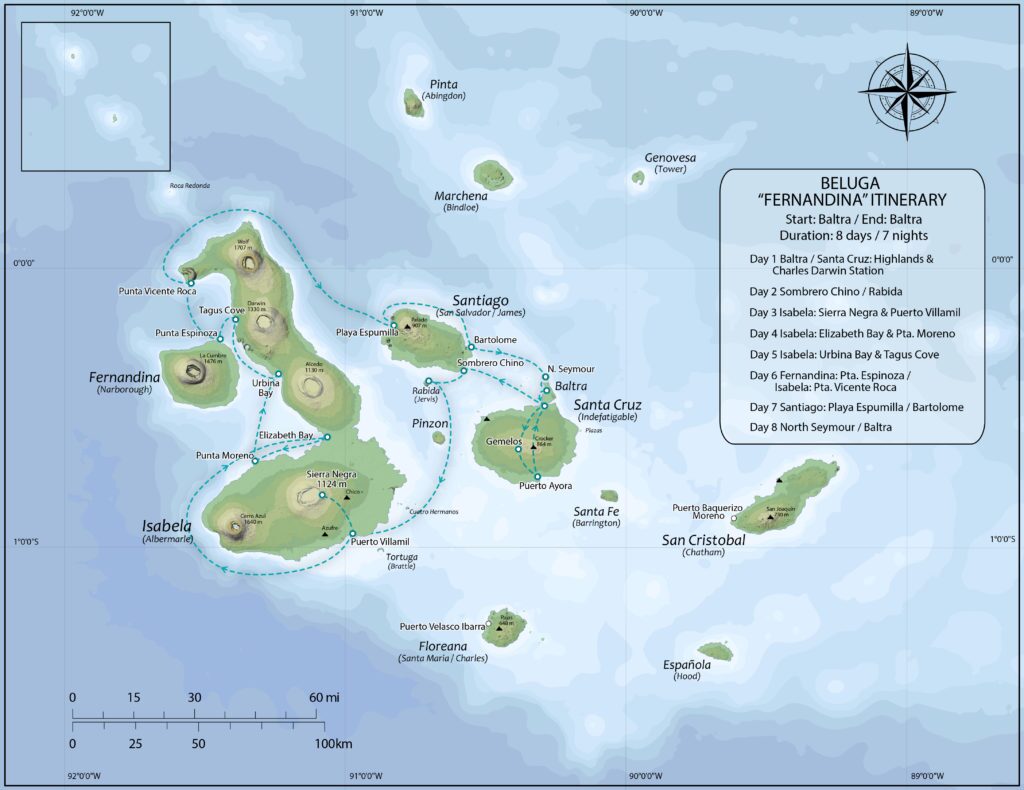
Day 1: Fly to Baltra, transfer to boat – Highlands – Charles Darwin Centre (L,D)
After landing in Galapagos, you first pay the national park entry fee and then leave the arrivals hall to where your guide will be waiting for you.
After getting the group together, the guide then takes you to the boat to settle in. The island of Baltra is the only island in the entire Galapagos archipelago that is not completely included in the National Park Area.
After lunch we head to the Highlands. The scenery gradually changes as we wind our way through all seven vegetation zones found in Galapagos. Here more than anywhere, on the most populated islands on the Galapagos, the problems of introduced animals and plants are quite obvious. This part of the island is not National Park. When we reach the highest point of the road, we are back in the National Park and we head to ‘El Chato’, a farm in the highlands where we can look out for the Galapagos Tortoises in their natural, and free, surroundings.
Next is our visit to the Charles Darwin Research Station. This gives you the opportunity to get to known the scientific work that’s currently taking place in the National Park, particularly projects raising the different subspecies of Galapagos tortoises. Scientists from all over the globe work at the station and conduct biological research from anatomy to zoology. It is also a good opportunity to observe the Galapagos tortoises close up.
Head to the yacht for dinner and briefing.
Day 2: Chinese Hat and Rabida Island (B,L,D)
So-called because of its resemblance to a Chinese Hat, this is a small, attractive island separated from the larger Santiago Island (also called James) by a narrow 200m channel. It boasts sea lions, marine iguanas and the Galapagos penguin.
We travel on to Rábida Island, where we find its iconic dark red coral sand beach. This is a small island but it charms with many wildlife highlights, such as flamingoes, pelican nesting sites, as well as a colony of sea lion bachelors. We take to the water for some snorkelling from the beach to round off our day.
Return to the yacht for a briefing and dinner.
Day 3: Isabela: Sierra Negra – Puerto Villamil (B,L,D)
This morning we’re going up an active volcano! Sierra Negra volcano is our destination.
It’s a dry landing at Puerto Villamil, where the population of Isabela lives, a small, sleepy outpost on the Galapagos. It’s a drive from the port (about 15 miles) to get to the start of the hike up the Sierra Negra volcano.
We climb, we see the different vegetation zones of the volcano and a short uphill hike takes us to the perimeter of the caldera. Once we reach the rim, we’ll have a nine-kilometre view that stretches across one the most active calderas in the world (2 hours’ walking, total time).
In Puerto Villamil, we take a beautiful trail from lagoon to lagoon and look out for Flamingos, Common Gallinules, White-cheeked Pintail Ducks and Black-necked Stilts as well as a forest of button mangroves.
We also visit the turtle breeding centre, and if conditions and time allow, Tintoreras or Los Humedales.
Return to the yacht for a briefing and dinner.
Note: Passengers on 6-day Hood itinerary take a 14.00 speedboat from Santa Cruz to Isabela to join the tour.
Day 4: Isabela: Punta Moreno & Elizabeth Bay (B,L,D)
In the morning we head to Elizabeth Bay. This bay is visited in the panga (zodiac) and the boat takes us right up to the tallest red mangrove trees in Galapagos. The entrance is through a very narrow channel, and once through, we’ll turn the motor off and drift/paddle towards “Las Marielas”, where a colony of nesting Penguins, Flightless Cormorants and giant marine iguanas are found. As we bob noiselessly in the water, keep an eye out for marine turtles.
After lunch aboard the boat, it’s to Punta Moreno. This site offers a hike on a rough lava field and is place where we can see all three species of cactus of Galapagos: candelabra cactus, prickly pear cactus and lava cactus. In the middle of the lava field some brackish water pools with Flamingos, Common Gallinules, White-cheeked Pintail Ducks and Paint-billed Crakes.
The site has spectacular views of volcanoes Alcedo, Sierra Negra and Cerro Azul. Some highlights include impressive lava flows, desolate and pristine landscape, varied and unusual arid zone vegetation.
Return to the boat for briefing and dinner.
Day 5: Isabela: Urbina Bay & Tagus Cove (B,L,D)
Alcedo volcano on Isabela island erupted in 1954 and the result is exposed in dramatic fashion at Urbina Bay.
Four miles of coastal seabed was uplifted and exposed after the eruption and marine remnants of coral skeletons, some of them waist-high, are visited after a wet landing on the beach.
This steep beach landing can be tricky when there are big waves. Once on the trail leading inland, look out the colourful land iguanas and Galapagos tortoises on the pathway. You may also encounter penguins while snorkelling here.
We return to the boat for lunch.
Tagus Cove is a protected cove on the western side of Isabela and was a favourite anchorage site for the early pirates and whalers who, over the centuries, carved and painted their names in the high cliffs of the cove. In the zodiac or kayak (if available), we can explore the coves here and look for Galapagos Penguins, Boobies, Pelicans and other seabirds. There is a hike here too, and it’s a dry landing, then heading uphill and the scenic hike to a salt-water lagoon, a scenic overlook with a spectacular view of the ocean, lava fields and volcanic formations.
At the end of the trail there is a wonderful view over the lava fields of the Darwin volcano.If the water is clear, Tagus Cove is a very interesting snorkelling spot – look out for marine invertebrates on the walls.
Return to the boat for briefing and dinner.
Day 6: Fernandina – Punta Espinoza – Isabela – Punta Vicente Roca (B,L,D)
Espinosa Point is one of the highlights of a cruise in Galapagos.
The dry landing is, depending on the tide, on lava or on the landing platform in the mangrove forest – and can also be a wet landing if the water is lively!
Fernandina is the youngest and most pristine of the Galapagos Islands, with no introduced animals. Recent lava flows formed by an active volcano stretch their way around the coast. We head off on a hike that showcases huge marine iguanas in big groups. Take care to stay on the pathway because the sand dunes are nesting areas for the marine iguanas.
At Vicente Roca Point (Isabela) the remnants of an ancient volcano form two turquoise coves with a bay well protected from the ocean swells. We take a panga ride along the cliff and explore a partially sunken cave at the water’s edge. Masked and Blue-footed Boobies sit perched along the point and the sheer cliffs, while Flightless Cormorants inhabit the shoreline.
There is an abundance of marine life that, in combination with the protection of the coves, make Punta Vicente Roca one of the archipelago’s sought after dive and snorkelling spots. Keep an eye out for seahorses, sea turtles, and the strange yet fascinating Mola mola (or sunfish).
Dinner and briefing.
Day 7: Santiago – Espumilla and Bucaneer's Cove – Bartolome (B,L,D)
Today we land at Santiago Island (James) , more specifically at Espumilla Beach at the islands Northwestern corner. This beautiful golden sand beach invites us to swim and snorkel, but we can also explore a fantastic system of mangroves – home to an array of wildlife. Sea Turtles are known to nest here and we could see flamingos and the Galapagos Hawk, amongst others.
We complete our visit with a stop at Bucaneer’s Cove, home to Charles Darwin for 9 days when he visited on his famous voyage. Whalers and pirates have passed the site, and contributed to its historic importance. We will embark on a panga ride, looking for the Galapagos Fur Seals, Brown Noodies, Pelicans, and Swallow-tailed Gulls
After lunch we arrive at Bartolome Island. This young island is inhospitable to most plants and animals and many visitors say walking here is like stepping into a different world.
The dry landing is on a jetty, then the summit trail and stairs lead us on a 30-minute climb to the top of Bartolomé, a once active volcano. Along the way, we pause to marvel at lava bombs, spatter cones and cinder cones. From the top of the wooden stairs, we can gaze out across the island for a panoramic view of the island and Pinnacle Rock, an eroded tuff cone.
Crystal clear water is an invitation to snorkel from the beach with schools of tropical fish and Galapagos, Penguins or take a zodiac ride to spot them.
Back aboard for our farewell dinner!
Day 8: North Seymour, transfer to Baltra airport, fly out (B)
At North Seymour you can able to see Galapagos sea lions, Blue-footed Boobies, and Magnificent Frigatebirds which are abundant here.
Alas, it’s time to say goodbye. Your guide accompanies you to the airport and you fly back to the continent, or stay on for more Galapagos exploration.
Prices From $5,850 / £4,756 per person
What's Included?
Accommodation, all meals plus purified water, tea and coffee, and snacks, naturalist bilingual Galapagos guides level II/III, shore excursions, snorkelling equipment, transfers in the Islands between the airport and dock
What's Not Included?
International flights, Round trip flights to the Galapagos Islands, Galapagos National Park fee, Galapagos Ingala fee, soft and alcoholic drinks, personal items, souvenirs, tips, wetsuit hire, travel insurance, personal items, Ecuador services
Accommodation
Beluga accommodates 16 passengers in 8 double cabins; one of these has an additional berth which becomes a triple room which is suitable for families.
Each cabin has their own private bathroom equipped with hot & cold water showers.
Beluga is fully air-conditioned, has spacious social areas with all the comforts and facilities of a first class motor yacht: panoramic windows in the salon / dining area, and a large sundeck for relaxing, sightseeing or sunbathing.
Tour Staff
The crews are “Galapagueños”, guides, captains and crew members were born and raised in the Galapagos Islands.
They know the area well and are prepared to show you the islands only like a native can do it.
The Naturalist, English-speaking guides have studied and been trained at Charles Darwin Scientific Station, and have long years of experience guiding at the Galapagos Islands.
Meals
The boat uses as much locally sourced produce as possible, including fish, coffee, eggs, fruits and meat farmed in Galapagos, to reduce carbon footprints and make sure the best ingredients are used.
The chef prepares three main meals a day, with snacks and drinks available after activities.
All dietary requirements can be catered for, vegetarians, vegans, lactose intolerant and more.
Breakfast usually features a juice, tea and coffee, toast, jams, eggs and pastries.
Lunch will include soups, then a main meal of rices, pastas, fish, omelettes and many more options, and often a small pudding.
Dinner will again be a hearty affair, with a starter, main meal and pudding, with water, teas and coffees available.
There is a bar with beers and cocktails available at extra cost.
Activity Level
Walks
Every visit to each island involves an easy or moderate walk, which can last between 2 to 3 hours, and are not considered strenuous. On these walks you will be led by an expert naturalist guides in a small group along clearly marked trails. They will explain in great detail all the wonders of each of our carefully selected itineraries. Most days there are two guided walks on a specific island where you will be able to walk and hike on beaches, lava fields, alongside cliffs and around mangrove estuaries.
Snorkelling
Snorkelling in the Islands is the highlight of the Galapagos cruise for many of our guests. You have the opportunity to go snorkelling almost every day – snorkelling with marine iguanas and with playful sea-lions are some of the highlights, as well as with green sea turtles, penguins and an incredible variety of colourful reef fish. On the western islands the water is a little colder but teaming with life. There are beach snorkels for beginners and deeper waters.
Zodiac rides
Dinghies, or “Pangas” as they are known in Galapagos, are inflatable zodiacs that serve as the main transportation method from our Galapagos yachts to the visitor sites. At several times during your week-long Galapagos travel adventure, you will have the chance to enjoy dinghy (or panga) rides in shores, mangrove estuaries, coves and caves.
Practical Information
Is this the cruise for me?
Eco-friendly, modern cruiser with plenty of space in rooms and on deck, plus a triple cabin for families.
Introduction to Galapagos
These magical islands comprise of 50 volcanic islands of varying shapes and sizes, which lie 1,000 kilometres off the coast of Ecuador.
Here, unlike anywhere else on Earth, you can enjoy a thousand close encounters with a weird and wonderful variety of ‘friendly locals’, including giant tortoises, fur seals, sea iguanas, frigate birds and blue-footed boobies.
Read our Galapagos Islands Guide and more about diving.
In 1535, Tomás de Berlanga, Bishop of Panama, floated into this archipelago and named it Galapagos after the giant tortoises he encountered. Pirates used the islands for refuge and to bury their stolen treasure after that.
The islands’ most celebrated visitor was Charles Darwin, who arrived aboard the HMS Beagle in 1835. The rare life forms he encountered helped him formulate his theory of evolution, which he published in The Origin of Species by Means of Natural Selection.
It wasn’t until 1959 when it became part of Ecuador’s national park system that this fragile ecosystem with its rare and endemic species came under protection.
In 1979 the Galapagos archipelago was declared a UNESCO World Heritage Site.
Weather in Galapagos
When to visit Galapagos Islands: weather and wildlife
There is no real ‘best’ time to visit Galapagos on holiday as there is always wonderful wildlife and weather to enjoy. Read our blog for more.
Most animals – tortoises, sharks, sea lions and boobies – are found year round and many of the species here are non-migratory.
The Galapagos Islands are located right on the equator so air and water temperatures do not vary by much.
Having said that, there are two recognised seasons, and each months brings natural marvels for the visitor to enjoy.
Below is our quick guide to the weather and wildlife you can find on the Galapagos Islands.
General weather information
The warm season (Jan-Jun)
- Calm, clear warm waters, great for snorkelling, often without a wetsuit.
- Great weather, with February and March being the hottest and sunniest months with blue skies and sunshine.
- Occasional heavy bursts of rain in the afternoons.
Sea temperatures: 22-25°C / 72-77°F
Land temperatures: 21-32°C / 72-90°F
The dry ‘garua’ season (Jun-Dec)
- It’s a great time for marine life in the cooler seas. Snorkellers may want a wetsuit.
- August and September the coolest when you may need a jacket in the evenings and the sea can be choppy.
- There can be mist on the islands in the mornings (garua) which usually burns off by midday leaving overcast skies or a sunny afternoon.
Sea temperatures: 15-22°C / 60-72°F
Land temperatures: 18-24°C / 65-75°F

Air and sea temperatures in Galapagos, month-by-month
Galapagos cruise kit list
Good kit is vital for every trip.
Book with Andean Trails and get 15% off Páramo’s fantastic ethical and high performance outdoor gear.
Galapagos – general advice
Galapagos is warm and humid, and you will need t-shirts (moisture wick-away or breathable t-shirts can be very useful, it can get very hot in the day), shorts, lightweight skirt or trousers and bathing suits.
One or two cotton shirts can be used to protect you from sunburn, especially when snorkelling (not very elegant worn in the water over a swimsuit, but practical – and Galapagos is NOT an elegant place!).
You may want to change into different clothes for the evening, but don’t take anything dressy or smart – there really is a very relaxed atmosphere on board.
Pack something warm for going on deck in the early morning or evening a fleece, maybe, and a sweatshirt – and a waterproof for the Highlands.
Strong sandals, trainers, or light hiking boots are ideal footwear – you may like to have something suitable for easy walks and another for tougher terrain – your guide will advise you daily what the walking will be like. Most boats ask passengers not to wear heavy shoes on board.
Do take a hat!
Seasickness tablets if you think you will have problems – i.e. Sturgeon, or Mareol if you buy them in Quito. The sea can be choppy, so it is recommended to take them as a precaution.
Galapagos – detailed kit list
- First aid kit – aspirin, imodium, sun tan lotion (facter 50 recommended), sunburn cream, lip salve, throat lozenges, insect repellent, etc.
- Earplugs – the engine can be noisy, whatever the boat, wherever your cabin.
- Sun glasses and sun hat.
- Snorkelling equipment – the boat either provides kit for free or has a supply for hire, but it may suit you better to take equipment in your size that you know will fit you. Even if you have not snorkelled before, DO have a go – under water Galapagos is a very special experience. Try it first of all from the beach, to get the hang of breathing through gritted teeth, then take the plunge!
- Towel, for the beach (most boats provide these, please ask).
- Money belt.
- Passport, with at least 6 months remaining from date of return from Ecuador.
- US Dollars cash and mixed denomination notes, undamaged and unmarked.
- Visa/MasterCard, Cash card.
- Personal & Medical insurance.
- Camera and film / memory cards (take at least twice the amount you think you will need!). You may want to take an underwater camera for snorkelling.
- Camera charger
- Binoculars
- Small backpack – to keep your sun cream, water, shirt etc in when you are on shore.
- Small plastic water bottle, 1-2 litres, depending on how much you drink.
- Biodegradable sunblock (v. high factor, 50+ recommended) and lip salve.
- Toiletries (featuring biodegradable soap).
- Wet Wipes/antiseptic hand wash cream
- Travel alarm clock.
- Sewing kit.
- Spanish/English phrasebook.
- Book, e-book, mp3 player/ipod or other for free time.
The Galapagos Islands are a very fragile environment and the arrival of more and more inhabitants to the islands, as well as tourist have an impact.
Please try to minimise your impact by:
- Bringing a water bottle to refill, rather than using a new bottle each time.
- Recycling your rubbish where possible, not leaving any rubbish behind.
- Taking batteries back home with you – they cannot be recycled properly in Ecuador.
- Saving water where possible.
- Leave toiletries that contain microbeads at home
- Saving energy by switching your lights off when you leave the room. Electricity on the islands comes from a generator, fuelled by petrol. For this same reason, please think about whether you really need to use your air conditioning.
Quito
Pleasantly warm during the day, but can be quite chilly during the morning or at night when you might want a jacket or a fleece, plus a waterproof.
You may want to dress up a little more in the evening here, depending on where you are staying, and what sort of restaurant you like.
Guayaquil
Conditions here are similar to Galapagos – hot and humid. T-shirts and shorts in the day, and like Quito, something smarter for eating out in restaurants at night.
ATOL holiday protection
Andean Trails has 25 years of experience of putting together the best South America holidays.
We pay a fee to the CAA for every licensable passenger we book since we hold an Air Travel Organiser’s Licence granted by the Civil Aviation Authority. In the unlikely event of our insolvency, the CAA will ensure that you are not stranded abroad and will arrange to refund any money you have paid to us for an advance booking.
We also offer ATOL (Civil Aviation Authority) protected holidays to give our customers peace of mind when booking and travelling.
When you buy an ATOL protected air holiday package from Andean Trails Ltd you will receive a Confirmation Invoice from us confirming your arrangements and your protection under our Air Travel Organiser’s Licence number 6275.
You can read more about ATOL, who is covered and what protections you have if not ATOL-covered, on our ATOL page.
What is ATOL?
The CAA’s ATOL scheme offers protection to your money and your holiday if you book with us. Not everybody is covered (see ‘Who is covered?’ for more), as you must purchase an ‘air package holiday’ with Andean Trails to be protected.
And ‘air package holiday’ is defined as including a flight and some ground services (hotel, transfer, trek etc). This is also known as an ‘ATOL-protected holiday’.
Who is covered?
To be covered by ATOL, you must book a flight and some ground services with us and be from the UK. If you are from the UK and only book ground services and no flights, you are not covered by ATOL (see below for more on how non-ATOL clients are covered).
If you are outside the UK and buy flights with us, you will be ATOL protected IF any of the flights booked with Andean Trails touches/stops in the UK at any point during your holiday package booked with us.
If you buy your flights elsewhere, please check with that agent if you are ATOL protected. Be careful with online flight purchases and make sure you know what protection you have, if any, before paying for flights.
Not all holiday or travel services offered and sold by us will be protected by the ATOL scheme. Please ask us to confirm what protection may apply to your booking.
For land only holidays not involving any air travel, in accordance with “The Package Travel, Package Holidays and Package Tours Regulations 1992”, all UK passengers booking with Andean Trails Ltd. are fully protected for the initial deposit and subsequently the balance of all money paid to us, arising from cancellation or curtailment of travel arrangements due to the insolvency of Andean Trails.
I’m not ATOL covered, what protection do I have?
If you are not ATOL covered, any payments you make to us go to a Trust account.
We can only access this money once your tour has been completed, meaning that if anything happens to Andean Trails Limited while you are on holiday, then your money is secure and you can either complete the trip or be able to make it home.
If you pay for your holiday with a credit card, some offer payment protection – please check with your cardholder.
You also should have cancellation protection written into your insurance (which we recommend you have at the time of booking) in case you need to cancel.
Floreana, Galapagos
Floreana is the least populated Galapagos island and yet home to its most scandalous tales!
Gossip aside, it is home to Post Office Bay, where a post barrel was erected in the late 18th century by English whalers. Passing sailors took the messages onwards – and it still functions today.
The nearby Devil’s Crown is one of Galapagos’ most special snorkels.
A (at times strong) current pushes you past the remains of a submerged volcano with its crater ‘horns’ still exposed, and you’ll see a brilliant array of colourful fish and corals.
Great viewpoints at Asilo de La Paz and Baroness view, too.
Isabela, Galapagos
Isabela is the largest and one of the youngest Galapagos islands, and its small human but enormous wildlife population make it perfect for cruises and hotel-based visits.
It also has a mile-long, pristine white-sand beach, with some small and cool bars to hang out in with some sundowners.
Must-do’s include Sierra Negra volcano and its active caldera, head to Los Tuneles to snorkel face-to-face with sharks and turtles and spend some time looking for penguins at Las Tintoreras.
Isabela is great for adventure and families alike.
For cruises only, Punta Vicente Roca is a lovely snorkel, and Urbina Bay is a top spot for wild giant tortoises and colourful land iguanas.
Kicker Rock, Galapagos
A truly impressive sight, Kicker Rock is the remains of an underwater volcano rising vertically 150m/492ft out of the sea.
The exposed cone has fractured in two, leaving a wildlife rich sea channel for us to enjoy, snorkelling or diving.
Jump in the water and drift with the gentle current through the cleft, keeping an eye out below for sea turtles, manta rays and maybe the odd harmless Galapagos shark, just to name a few.
Hammerheads are occasionally seen here too.
On the cliffs, we can spot Blue-footed Boobies, Nazca Boobies and magnificent Frigate birds. A memorable snorkel.
Santa Cruz, Galapagos
Almost everyone will visit Santa Cruz during a Galapagos stay.
It’s popular because of the incredible variety of habitat and animals go alongside its strategic location.
The famous Charles Darwin Centre is a must, as is a visit to see Giant Tortoises and a kayak in the turquoise waters at Garrapatero beach.
There are a plethora of great dive and snorkel sites nearby, lively bars and some good beaches for relaxing, like Tortuga Bay.
Most cruises start or end here, and the majority of flights come to Santa Cruz, plus there are many accommodation options, from basic to luxury.
Santiago (James), Galapagos
Curious, dark sand greets the visitor to this centrally-located island.
Marine iguanas may join you for a snorkel after warming up in the sun, along with white-tipped reef sharks, rays, surgeon and parrotfish and turtles.
Crabs, sea lions and spectacular blowholes line the shore.
On the other side of the island, red sand cliffs are home to many seabirds, and Bucaneer cove tells its own whaling and pirate history.
A group of nearby small rocky islands called Bainbridge Rocks feature a stunning, turquoise saltwater lagoon that is home to flamingos.
The Galapagos Islands
The Galapagos is an ideal year-round destination, with its volcanic landscapes and tame wildlife.
Whether you cruise or stay in a hotel, you are guaranteed to see giant tortoises, sea lions, iguanas and blue-footed boobies to name a few, plus amazing volcanic formations and stunning beaches.
No trip here is complete without diving or snorkelling – turtles, rays, schools of fish, and for the lucky, hammerhead and whale sharks.
Divers can enjoy some of the best underwater diving in the world on liveaboard cruises to remote and spectacular dive sites.
Tower (Genovesa), Galapagos
Flung way out to the north of the archipelago, this spectacular island is a Galapagos in miniature.
Its remote location meaning very few people make it this far.
Sea lions, sharks and Flightless Cormorants will no doubt accompany you on snorkels in deep waters as well as close to the beautiful, white-sand bay.
A multitude of birds nest at Tower, and it’s the only place you’re sure to see the Red-Footed Booby, as well as the chance to spot petrels, owls, gulls and more.
Prices From $5,850 / £4,756 per person
2025:
8 days (Wed - Wed) USD 5,850 per person
6 days (Fri - Wed) USD 4,400 per person
Price per person, shared cabin basis
Single supplement 50%- ask about cabin shares
Christmas and New Year supplement $200pp
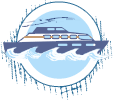
Dates & Prices
Prices From $5,850 / £4,756 per person
2025:
8 days (Wed - Wed) USD 5,850 per person
6 days (Fri - Wed) USD 4,400 per person
Price per person, shared cabin basis
Single supplement 50%- ask about cabin shares
Christmas and New Year supplement $200pp
Can’t find what you’re looking for? Get in Touch
+44 (0)131 378 5593
+44 (0)131 554 6025



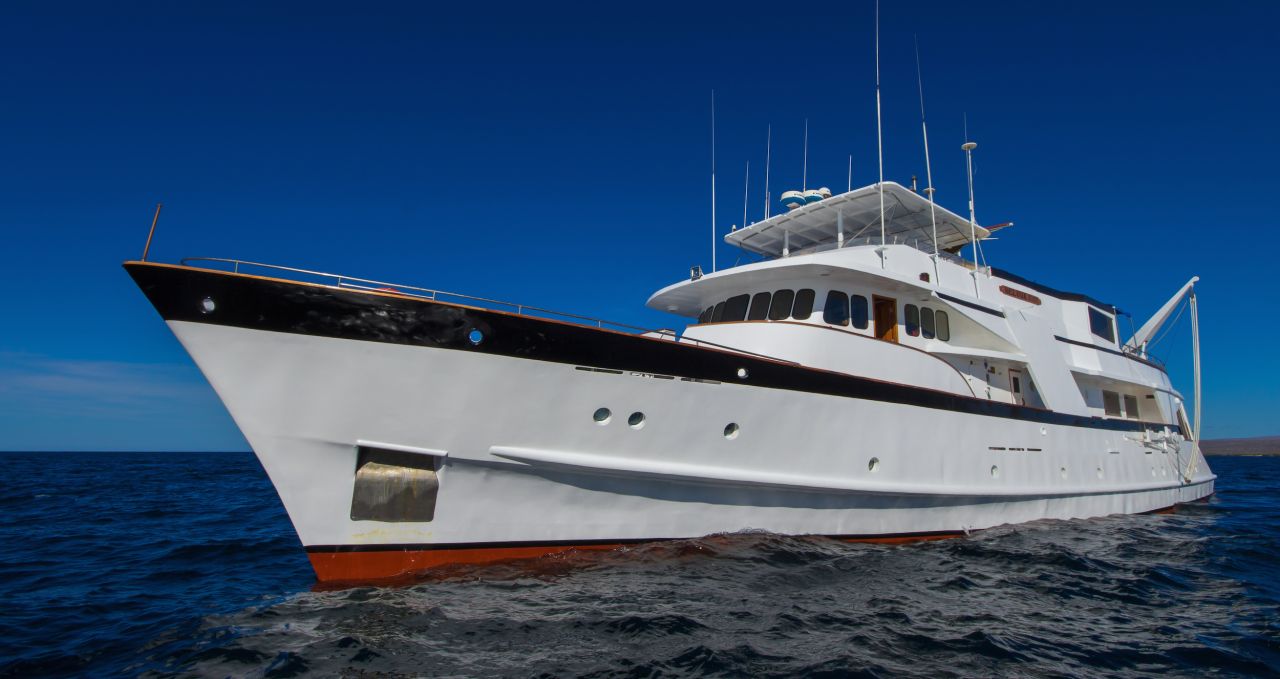
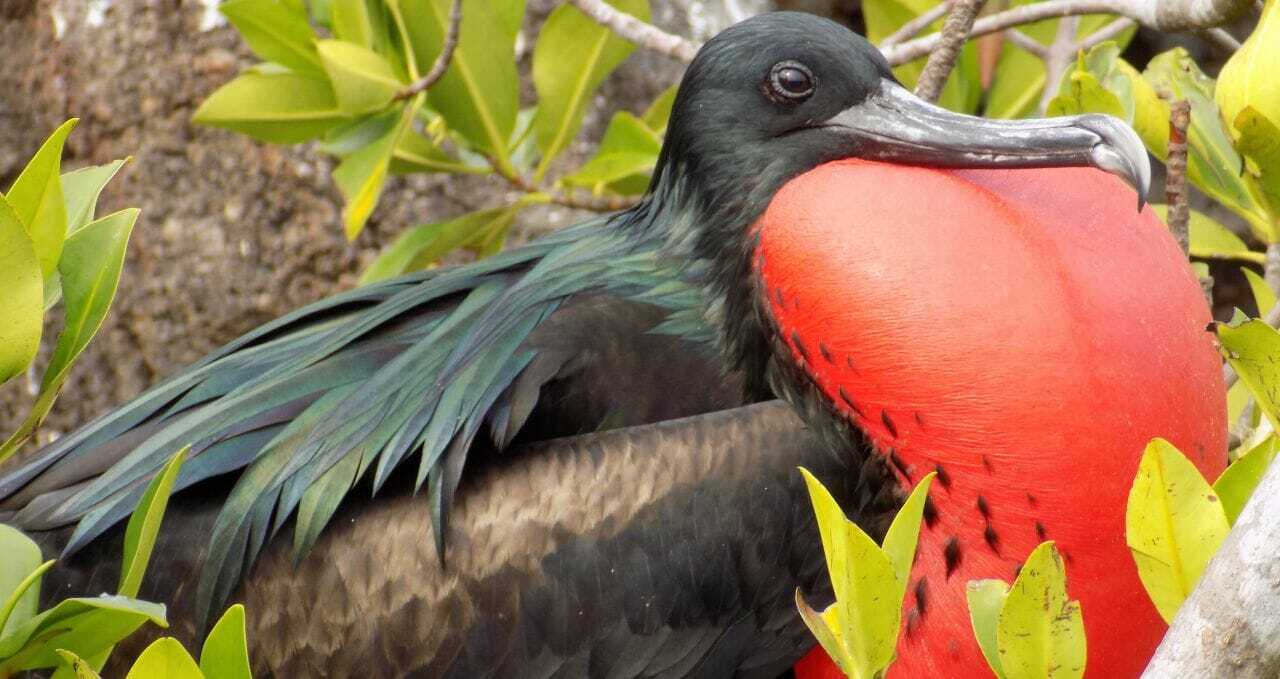
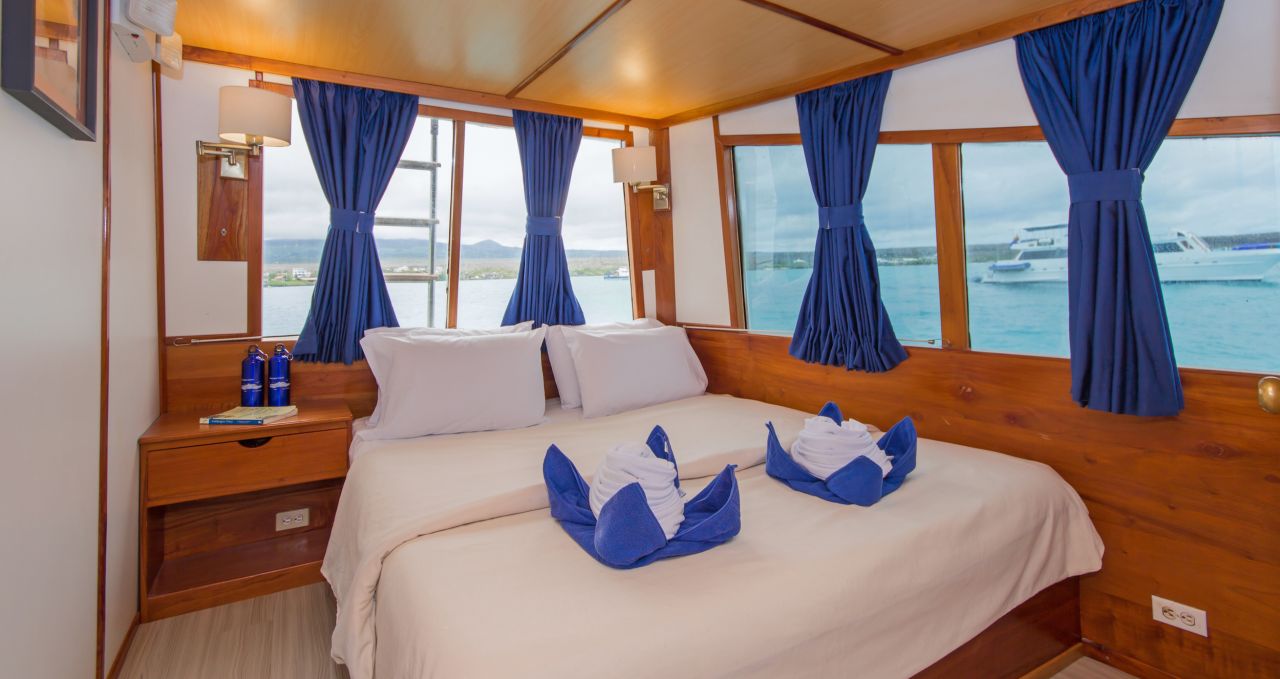
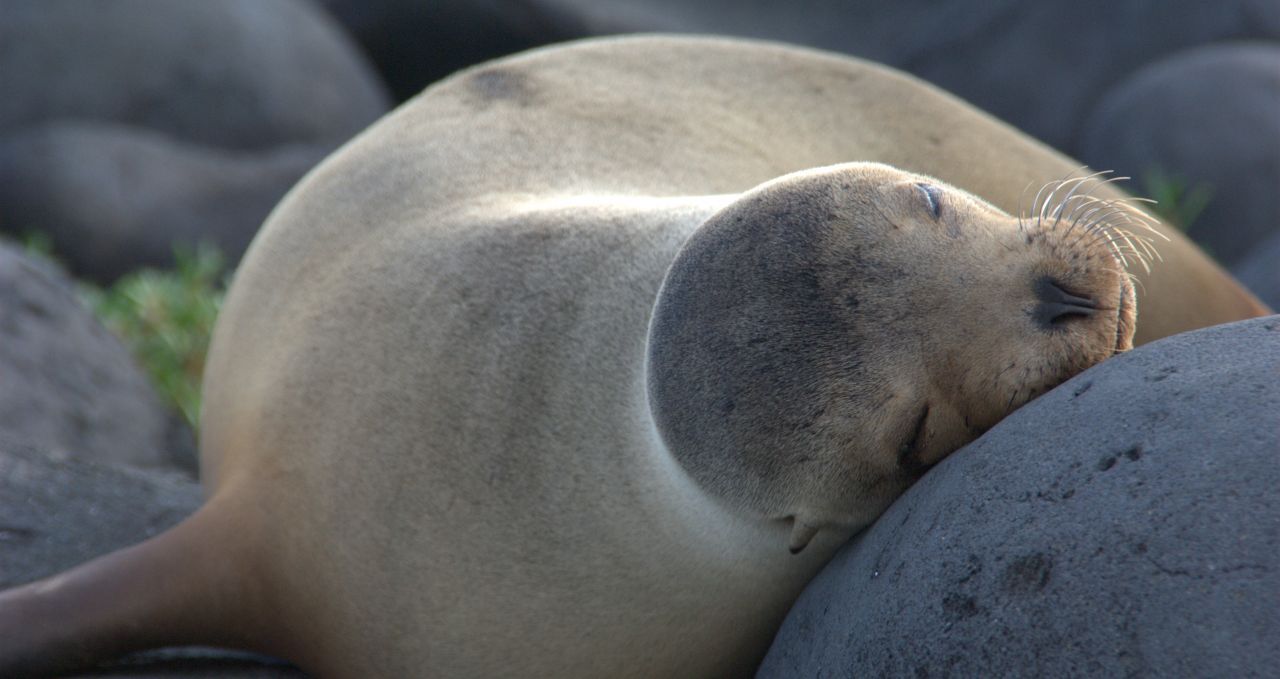
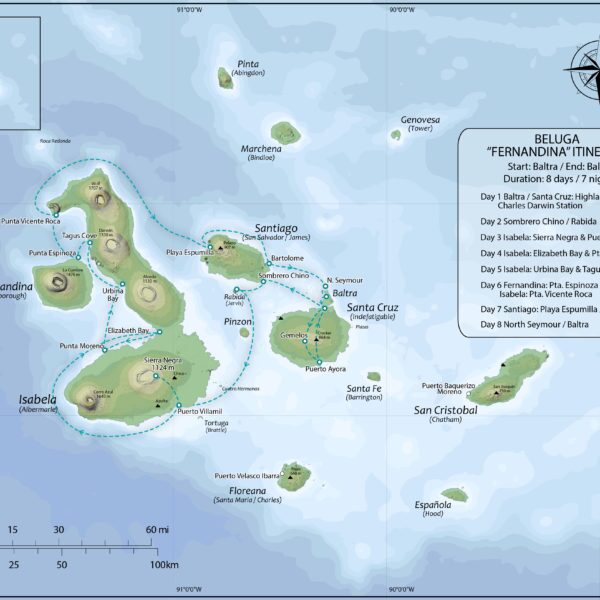
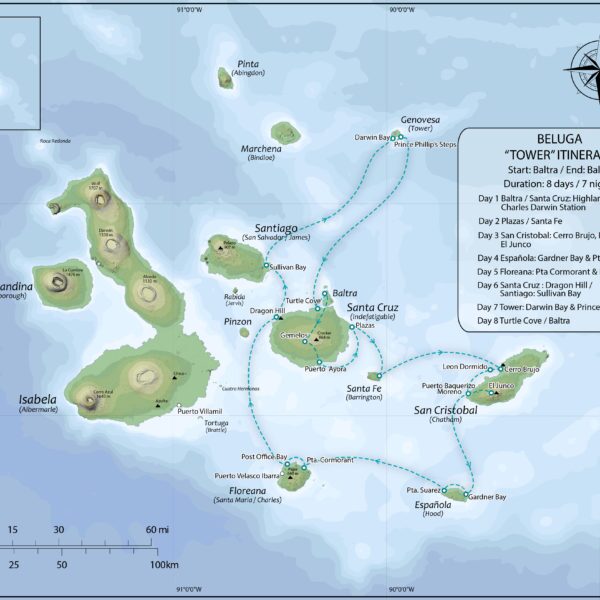
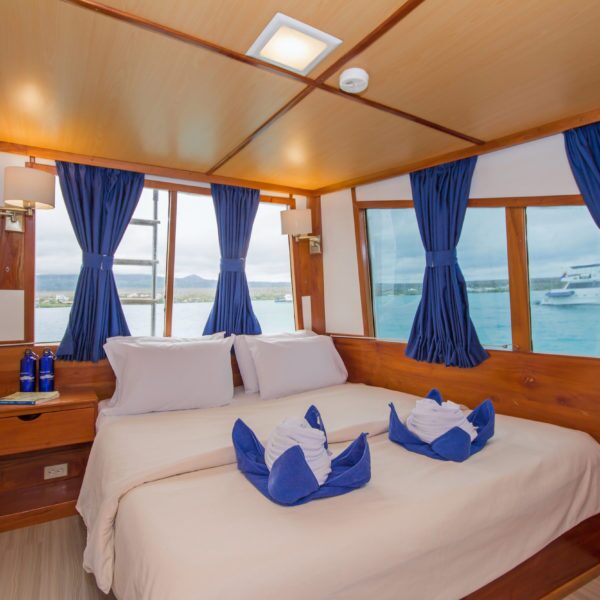
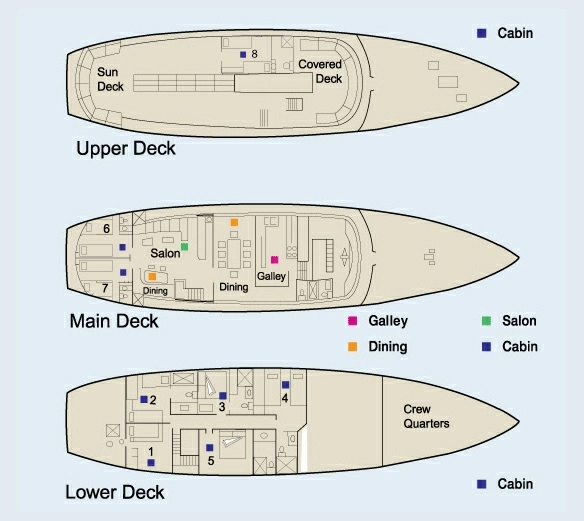
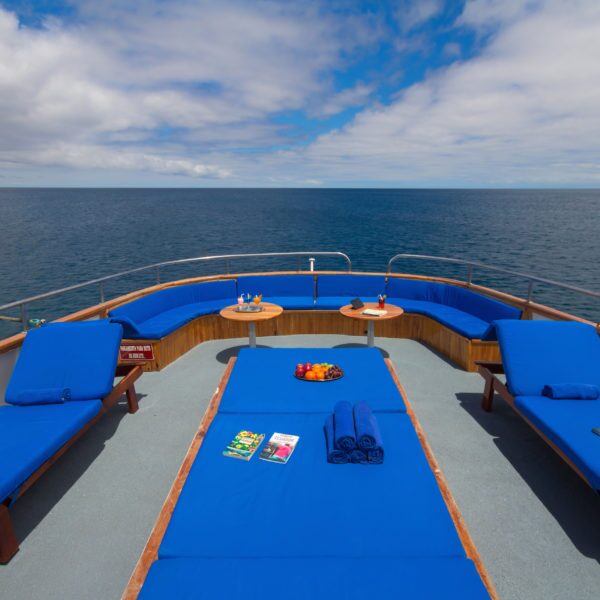
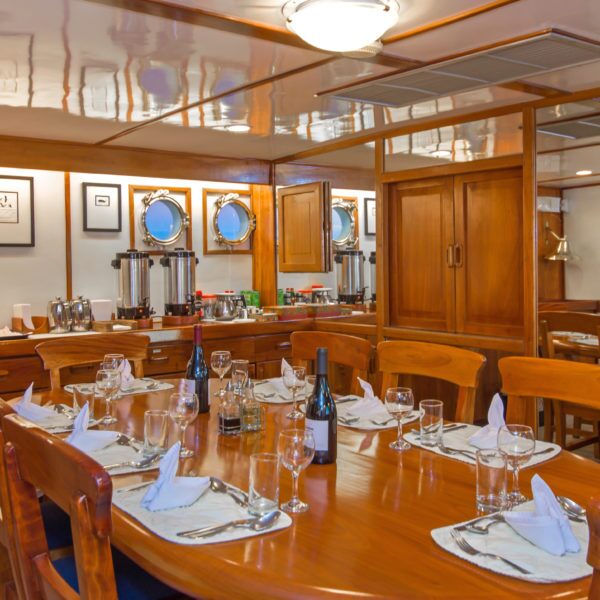
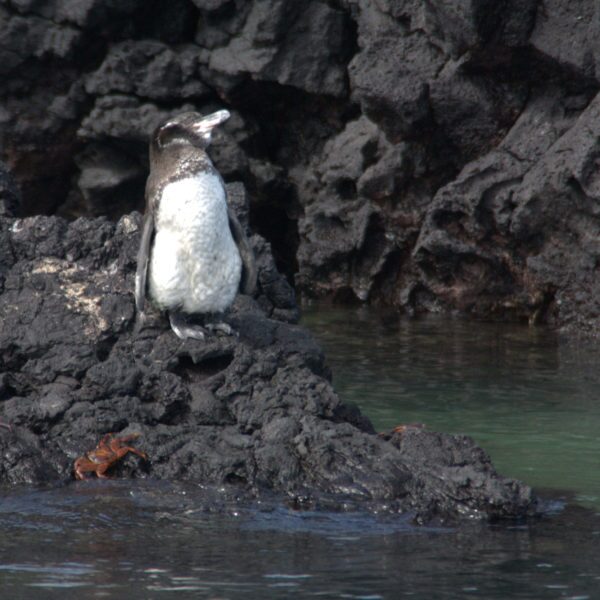
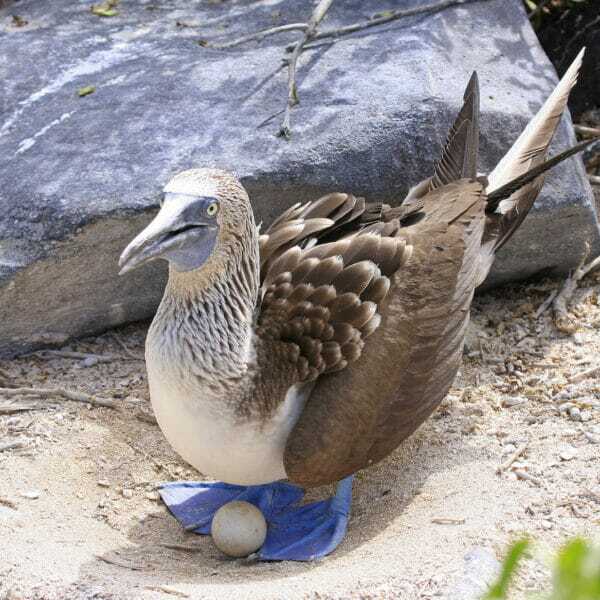
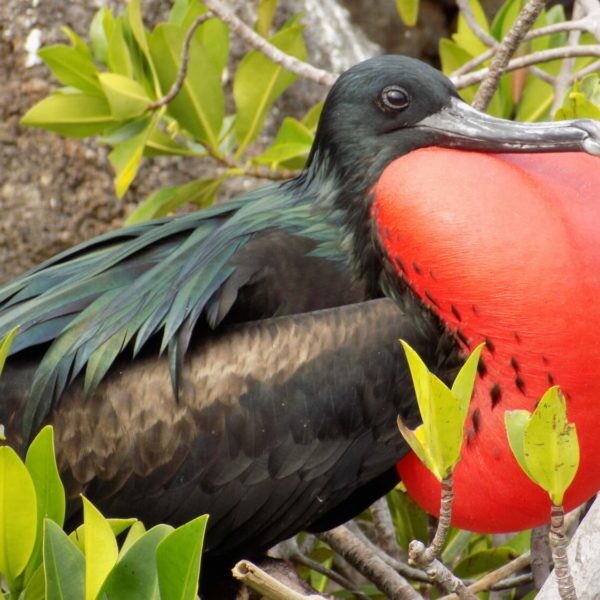
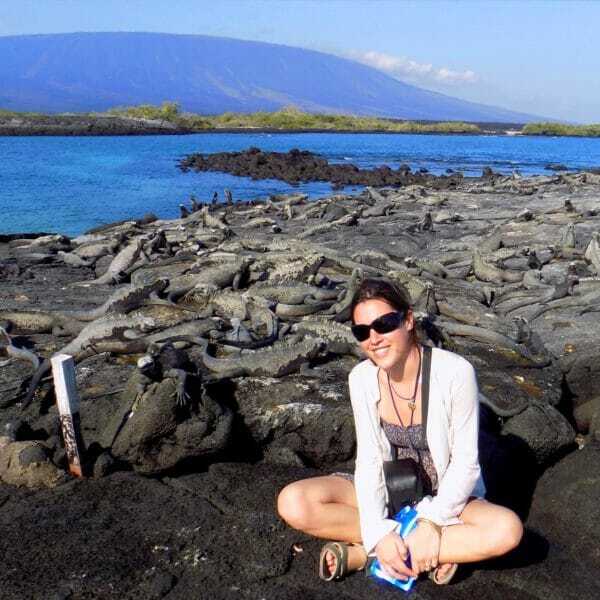
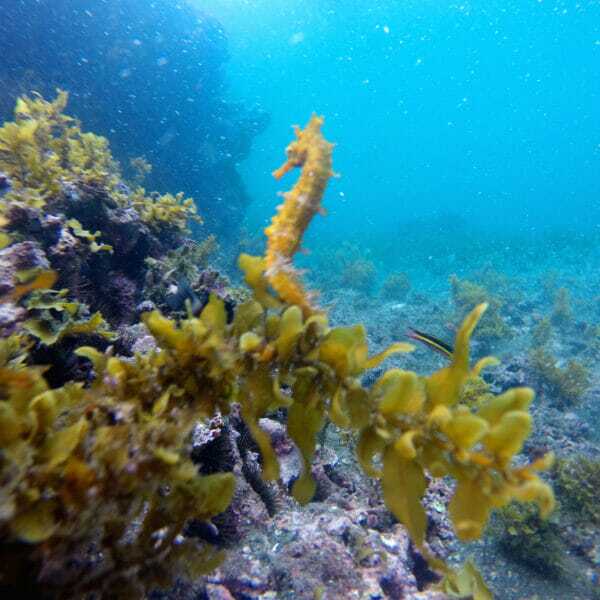
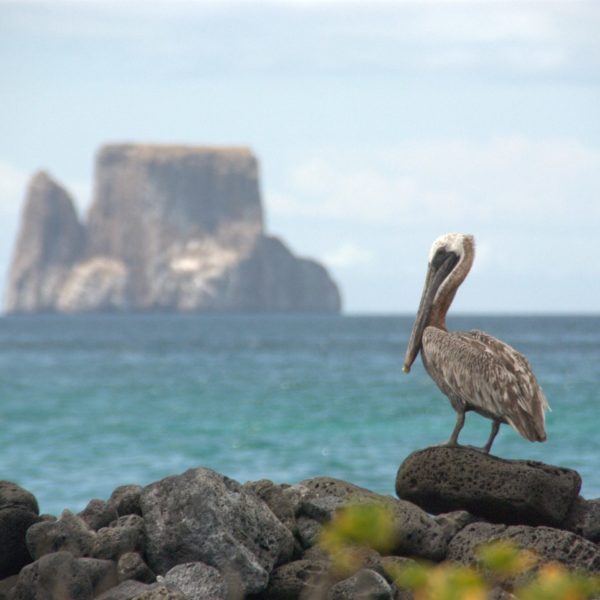
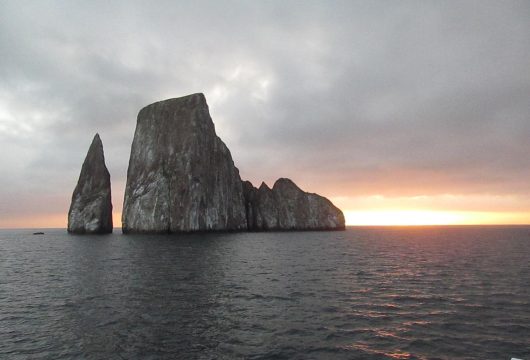

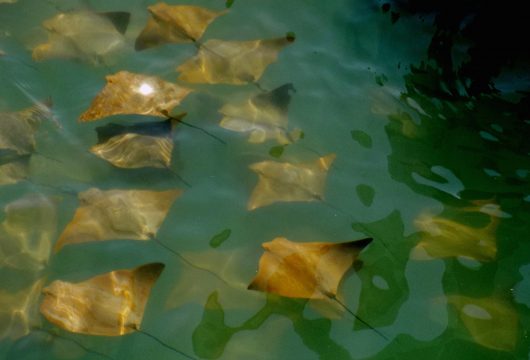
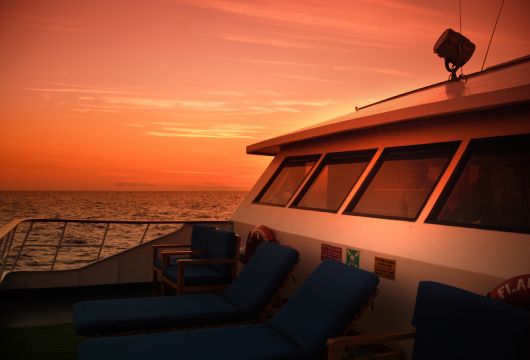
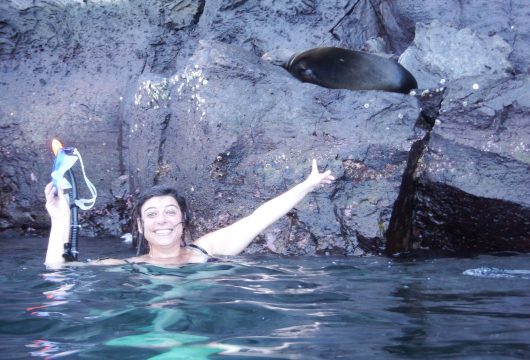
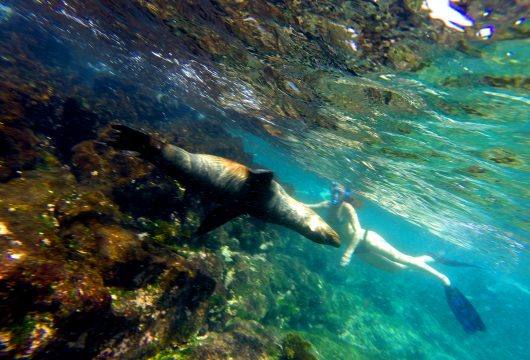
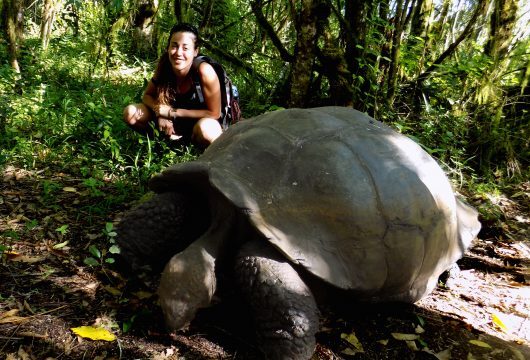
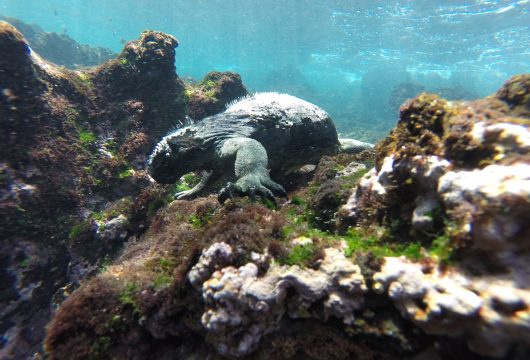
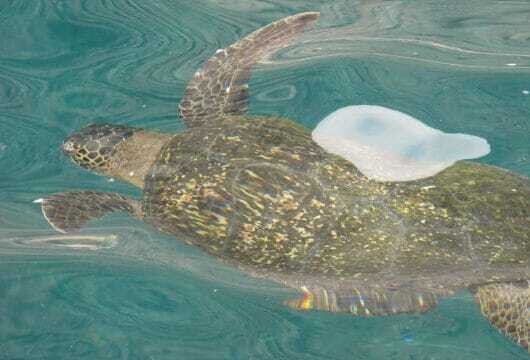
 a Group Tour
a Group Tour 